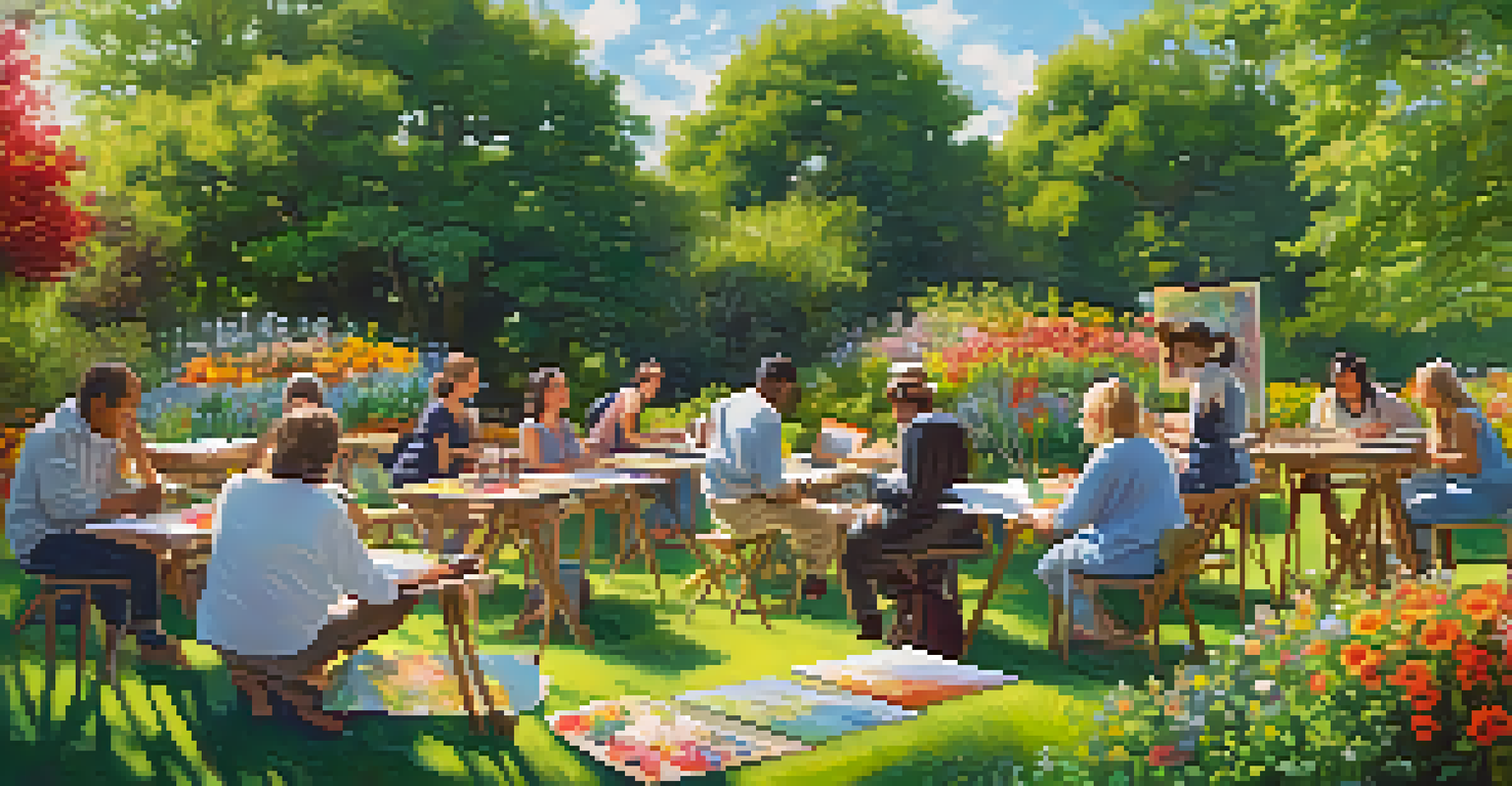The Impact of Art and Creativity in Wellness Retreats

Understanding Wellness Retreats and Their Benefits
Wellness retreats are designed to foster mental, physical, and emotional well-being. They often combine activities like yoga, meditation, and nature walks to promote relaxation and self-discovery. By stepping away from daily stressors, participants can recharge and focus on personal growth.
Art enables us to find ourselves and lose ourselves at the same time.
These retreats provide a safe space for individuals to explore their feelings, connect with others, and learn new coping strategies. With a focus on holistic healing, wellness retreats aim to address the mind-body connection, leading to a more balanced life.
Incorporating art and creativity into these retreats enhances the experience, allowing guests to express themselves in unique ways. Whether through painting, writing, or music, creative activities can unlock emotions and facilitate healing.
The Role of Art in Personal Expression and Healing
Art serves as a powerful tool for personal expression, enabling individuals to communicate feelings that may be difficult to articulate. For many, engaging in creative endeavors is a form of therapy, helping to process emotions and release pent-up stress. The act of creating can be cathartic, leading to a sense of clarity and relief.

Moreover, creating art in a group setting fosters connection and community. Participants often share their creations, which can lead to discussions and insights that deepen relationships and enhance the overall retreat experience. This sense of belonging can significantly contribute to emotional healing.
Wellness Retreats Foster Healing
These retreats combine activities like yoga, meditation, and art to promote mental, physical, and emotional well-being.
By providing a platform for self-exploration, art encourages individuals to confront their challenges and celebrate their achievements. As they navigate their creative journey, guests can discover new aspects of themselves, paving the way for personal growth and transformation.
Creativity as a Catalyst for Mindfulness
Engaging in artistic activities can naturally lead to a state of mindfulness, where individuals become fully immersed in the present moment. This focus on the here and now can help participants let go of anxieties and distractions, fostering a sense of peace and tranquility. Mindfulness is a key component of wellness, as it promotes mental clarity and reduces stress.
The creative process is a process of surrender, not control.
Artistic expression often requires concentration and intention, which can enhance one's ability to remain present. Whether it's the gentle strokes of a paintbrush or the rhythmic sounds of a musical instrument, creativity encourages a flow state that is deeply meditative. This connection to the present can have lasting benefits beyond the retreat experience.
By integrating mindfulness practices with creative outlets, wellness retreats can offer a comprehensive approach to personal development. This combination allows participants to cultivate a greater awareness of their thoughts and feelings, leading to improved emotional regulation and resilience.
Building Community Through Creative Collaboration
Wellness retreats often emphasize the importance of community, and art can play a significant role in bringing people together. Collaborative projects, like group paintings or community murals, foster teamwork and shared experiences. These activities can break down barriers, allowing participants to connect on a deeper level.
Working together on a creative endeavor encourages communication and trust, essential components of any supportive community. As individuals share their ideas and skills, they create bonds that extend beyond the retreat. This sense of camaraderie can lead to friendships that last long after the retreat ends.
Art Enhances Personal Growth
Engaging in creative activities allows individuals to express emotions, deepen connections, and facilitate healing.
In essence, creative collaboration not only enhances the retreat experience but also cultivates a sense of belonging. Participants leave feeling more connected to themselves and others, which can profoundly impact their overall well-being and happiness.
Art Therapy: A Structured Approach to Wellness
Art therapy is a recognized therapeutic approach that combines the creative process with psychology. In the context of wellness retreats, trained art therapists guide participants through structured activities designed to promote healing and self-exploration. This professional guidance ensures that guests can navigate their emotions safely and effectively.
Through art therapy, individuals can explore complex feelings, confront trauma, and develop coping strategies. The creative process allows for self-discovery in a non-threatening environment, making it easier to address difficult topics. Participants often leave these sessions feeling lighter and more empowered.
Integrating art therapy into wellness retreats adds a layer of depth to the experience, providing participants with valuable tools for emotional regulation. The skills learned during these sessions can be applied long after the retreat, promoting ongoing personal growth and resilience.
The Transformative Power of Nature and Art
Nature has a profound impact on well-being, and when combined with art, it can create a transformative experience. Many wellness retreats are set in serene natural environments that inspire creativity and reflection. The sights, sounds, and sensations of nature can enhance artistic expression and deepen the healing process.
Engaging in outdoor art activities, such as plein air painting or nature-inspired crafts, allows participants to connect with their surroundings. This connection can foster a sense of peace and grounding, helping individuals feel more centered and relaxed. The beauty of nature can spark creativity, leading to unique and meaningful artistic expressions.
Nature and Art Create Transformation
Combining the beauty of nature with artistic expression fosters a holistic experience that nurtures both mind and spirit.
By intertwining nature and art, wellness retreats create a holistic experience that nurtures both the mind and spirit. Participants often report feeling rejuvenated and inspired, carrying this newfound energy into their daily lives.
Crafting a Lasting Legacy of Creativity and Wellness
The impact of art and creativity in wellness retreats extends far beyond the duration of the event. Participants often leave with a renewed sense of purpose and a commitment to continue their creative practices at home. This newfound passion can lead to lasting changes in their lifestyle and overall well-being.
By embracing creativity as a regular part of their lives, individuals can enhance their emotional health, reduce stress, and foster personal growth. Whether through journaling, painting, or participating in community art projects, the benefits of creativity can be integrated into daily routines.

In essence, wellness retreats not only provide a temporary escape but also empower individuals to cultivate a lifelong relationship with art and self-care. This legacy of creativity can lead to a more fulfilling and balanced life, reflecting the true essence of wellness.